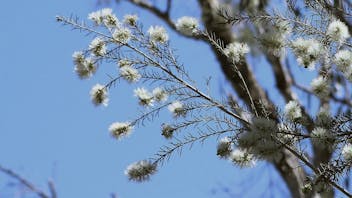Product Overview
PLEASE NOTE: we are unable to ship this product internationally due to CITES regulations.
We are pleased to offer this fine organic Rosewood Leaf essential oil as a sustainable alternative to the essential oil distilled from the wood of the endangered Rosewood trees. The aroma is fresh, bitter green-woody, and highly aromatic, with slight camphoraceous and faint rosy nuances; the green-woody notes soften, deepen and become sweeter in the long, mellow drydown. In perfumery, Rosewood oil distilled from the wood blends well with most oils and is attributed with rounding off sharp edges and adding body to perfume formulations.[1] Aromatically speaking, Rosewood Leaf essential oil would have reasonably similar qualities. This oil is CITES compliant.
A vigorous evergreen tree in the Lauraceae family, Aniba rosaeodora can attain heights of nearly 100 feet with a diameter of 6 to 7 feet. The essential oil from the wood has, for decades, been sought after by perfumers and fragrance manufacturers of all types of products for its smooth, woody, rosy aroma, thanks to its dominant constituent – linalool. Every part of this massive forest giant is fragrant – the wood, the roots and the leaves, although, before this species gained protected status, it was the wood oil that had been one of the most highly traded essential oils in the world. Now, thanks to a number of projects dedicated to the sustainable harvest and distillation of Rosewood Leaf, we know that cultivated trees as young as four years old can produce essential oils with nearly the same chemical make up as that from the wood of older trees.[2]
It is difficult to present an essential oil from Rosewood without acknowledging the extreme pressure this species has endured. Although perfumery played its part in Rosewood’s fate, also responsible for the demand of the wood is the exploitation by ‘timber mafias’ as well as its use in industries like fine furniture, musical instruments, and even chop sticks.[3] Sometimes referred to as ‘the ivory of the forest’, Rosewood is the most trafficked form of flora/fauna in the world; its depletion adversely affects wildlife and leads to desertification of terrain – leaving areas vulnerable to fires and spawning many acts of violence in once peaceful regions.[4] This is why it is so important to verify that the source of Rosewood Leaf essential oil is indeed from the leaves and is CITES certified.[5] Today, there are many organizations involved in reforestation and sustainability projects in these devastated regions.[6],[7]
One of the most commercially successful perfumes of all time, Chanel No 5, debuted in 1921; it was a stunning departure from the flowery perfumes of the era. Featuring a liberal dose of synthetic aldehydes seductively combined with naturals, it included a generous helping of Rosewood, plus Jasmine, Neroli, Ylang Ylang, Sandalwood and Vetiver.[8] The precious Rosewood aroma found in our sustainably produced Rosewood Leaf essential oil will be enthusiastically welcomed by those who have abstained from and missed the warm aromatic embrace of this extraordinary rainforest survivor.
1 Lawless, Julia. The Encyclopedia of Essential Oils, 2013, p. 175.
2 Rosewood Exploitation in the Brazilian Amazon Options for Sustainable Production
3 U.N. Issues New Protections for Rosewood Trees
4 The Rosewood Trade - The Illicit Trail from Forest to Furniture
5 https://cites.org/eng/search?search_api_fulltext=aniba+rosaeodora
6 Planting Rosewood for Sustainable Essential Oil Production
7 https://www.caminoverde.org/blog/regeneratingrosewood
8 https://revistapesquisa.fapesp.br/en/2005/05/01/rosewood-perfume-no-5-brazil/



